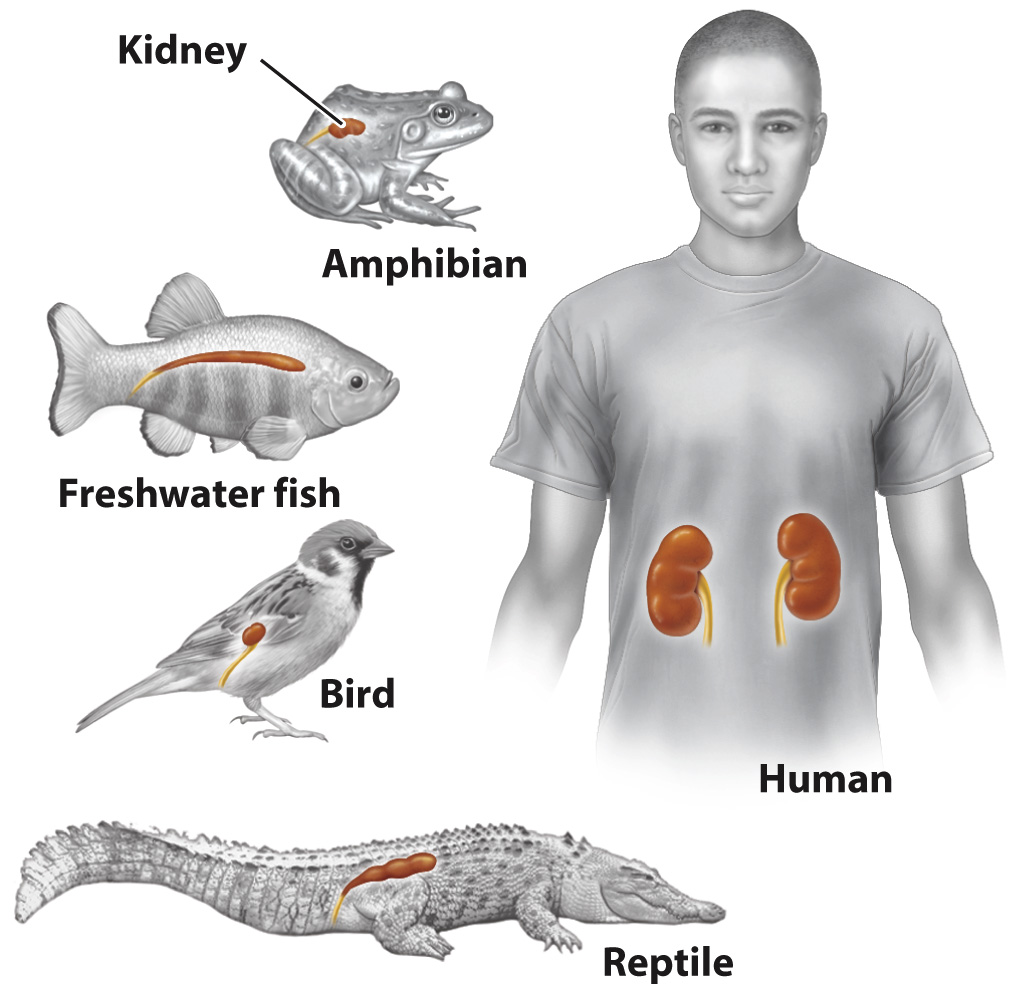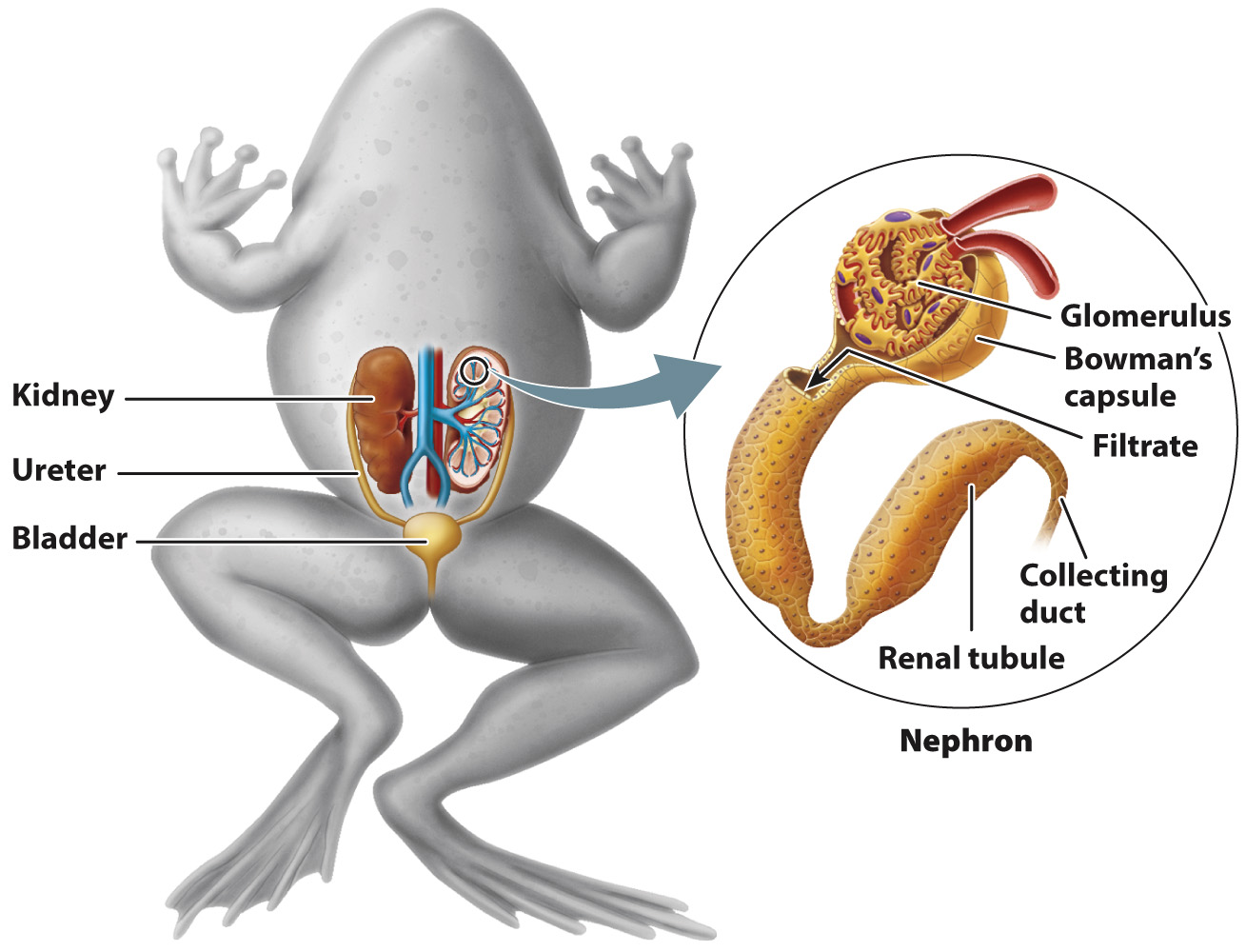Vertebrates filter blood under pressure through paired kidneys.
The excretory organs of vertebrates are the kidneys. Like all excretory organs, they not only serve to eliminate wastes, but also play an important role in maintaining water and electrolyte balance. Vertebrate kidneys also reflect the evolutionary transition of vertebrates from an aquatic to a terrestrial environment, where there is a need to minimize water loss. Mammals and birds, for example, can excrete urine that is more concentrated in solute than their blood and tissues.
The kidneys lie posterior to the abdominal cavity. The kidneys of humans and other mammals are bean-

Vertebrates filter their blood through specialized capillaries that have openings in their walls. These porous capillaries form a tufted loop called a glomerulus (Fig. 41.13). There are thousands to millions of glomeruli in each kidney. Driven by circulatory pressure, nitrogenous wastes, electrolytes, other small solutes, and water move through small holes in the capillary walls into an extracellular space surrounded by a capsule (called Bowman’s capsule after the surgeon William Bowman, who identified it in 1842). The filtrate then moves through a series of renal tubules, which further process the filtrate by reabsorption and secretion before it enters the collecting ducts as urine. The collecting ducts converge on a larger tube called the ureter, which brings urine from the kidneys to a hollow organ called the bladder for storage and elimination from the body.

The glomerulus, capsule, renal tubules, and collecting ducts make up a nephron, the functional unit of the kidney. Nephrons perform the three basic steps of excretion and osmoregulation: filtration of blood passing through the glomerulus, reabsorption from the renal tubule back to the bloodstream of key electrolytes and solutes, and secretion of additional wastes and electrolytes by the renal tubules.
In saltwater and freshwater fish, the kidneys run along the length of the body, with nephrons arranged segmentally. Because fish excrete nitrogenous waste in the form of ammonia through their gills, the kidney is primarily an organ of water and electrolyte balance rather than one of waste elimination. Recall that saltwater and freshwater fish face different challenges in achieving water balance. Saltwater fish must eliminate excess electrolytes that enter through their gills and in the sea water that they drink, whereas freshwater fish must eliminate excess water that enters through their gills. In saltwater fish, the renal tubules are readily permeable to water, allowing water to diffuse out of the tubule by osmosis, and producing relatively concentrated urine (high concentration of electrolytes and low concentration of water). By contrast, the renal tubules in freshwater fish are relatively impermeable to water while allowing reabsorption of electrolytes, sugars, and amino acids. This enables freshwater fish to excrete very dilute urine, eliminating the excess water that continually enters through their gills.
The kidneys of amphibians are similar to those of freshwater fish. Amphibians take in excess water across their gills and skin as they breathe. Amphibian kidneys therefore produce extremely dilute urine, enabling them to maintain an electrolyte concentration in their body that exceeds that of their freshwater environment.
Reptiles are found in a variety of habitats, from oceans to deserts, and are well adapted to their environments. Marine iguanas, for example, ingest salt water with their food, and so rely on specialized salt glands to eliminate excess electrolytes from their body. Terrestrial reptiles living in desert regions face the challenge of minimizing water loss in an environment of limited water availability. Because reptiles excrete nitrogenous waste in the form of uric acid, they are able to reabsorb most of the water from the urine. This process allows many reptiles to inhabit extremely dry environments.
Mammals also live on land, but they excrete most of their nitrogenous waste in the form of urea dissolved in water. Their kidneys are well adapted for excreting waste and balancing their water and electrolyte levels, as we discuss now.